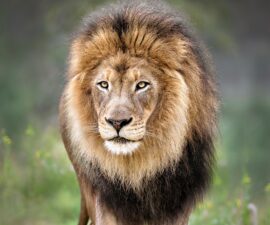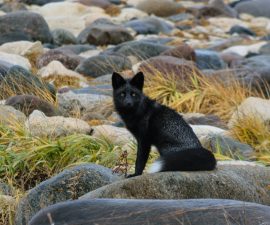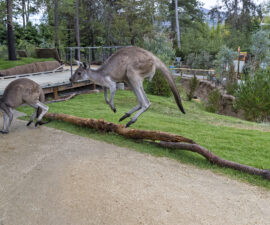 Fourteen fledglings flutter about in San Diego Zoo Global’s aviaries in Hawai‘i, under the care of conservation biologists. These young birds represent hope for a small Hawaiian bird species known as the ‘akikiki. The group represents the first of this species to be reared in a captive environment and the beginning of a breeding program designed to save this species from extinction.
Fourteen fledglings flutter about in San Diego Zoo Global’s aviaries in Hawai‘i, under the care of conservation biologists. These young birds represent hope for a small Hawaiian bird species known as the ‘akikiki. The group represents the first of this species to be reared in a captive environment and the beginning of a breeding program designed to save this species from extinction.
“The ‘akikiki has shown steep declines over the past 10 to 15 years, and now numbers fewer than 500 birds,” said John Vetter, Forest Bird Recovery Coordinator of the State of Hawai‘i Department of Land and Natural Resources’ (DLNR) Division of Forestry and Wildlife. “A panel of experts in Hawaiian forest bird conservation was convened to identify steps needed to preserve this species, and ranked the initiation of a captive breeding population as one of the highest priorities for its survival.”
‘Akikiki eggs were brought to the San Diego Zoo Global facility earlier in 2015 through a collaborative effort with the Kaua‘i Forest Bird Recovery Project (KFBRP), Hawai’i’s DLNR Division of Forestry and Wildlife, and the U.S. Fish and Wildlife Service-Pacific Islands Fish and Wildlife Office (USFWS-PIFWO). Very little is known about this species, and these birds have not been raised in a zoological setting before. However, conservationists with San Diego Zoo Global have worked successfully with a number of other similar native Hawaiian birds and are using these techniques to ensure that the species will thrive.
“Using another species that we previously worked with as a model, we were able to successfully rear these 14 ‘akikiki at our centers in Hawai‘i,” said Bryce Masuda, Conservation Program Manager, San Diego Zoo Global. “This group of young birds will start a breeding population, protected in captivity from the threats bringing this species to the brink of extinction in the wild. Their presence provides insurance that we can protect this species now, for future generations.”
The ‘akikiki is a species of Hawaiian honeycreeper found only on the island of Kaua‘i. This species has been severely affected by introduced diseases such as avian malaria, loss of native forest habitat, hurricanes, and the introduction of non-native predator species in the wild.
“We are currently working with partners to address the threats to ‘akikiki in the wild, in order to ensure a successful reintroduction in the future,” said Michelle Clark, Biologist, Pacific Islands Fish and Wildlife Office.
Bringing species back from the brink of extinction is the goal of San Diego Zoo Global. As a leader in conservation, the work of San Diego Zoo Global includes onsite wildlife conservation efforts (representing both plants and animals) at the San Diego Zoo, the San Diego Zoo Safari Park, and San Diego Zoo Institute for Conservation Research, as well as international field programs on six continents. The work of these entities is inspiring children through the San Diego Zoo Kids network, reaching out through the Internet and in children’s hospitals nationwide. The work of San Diego Zoo Global is made possible by the San Diego Zoo Global Wildlife Conservancy and is supported in part by the Foundation of San Diego Zoo Global.
KFBRP is a collaboration between the Pacific Studies Cooperative Unit of the University of Hawai’i and the DLNR Division of Forestry and Wildlife. KFBRP’s mission is to promote knowledge, conservation of Kauai’s native forest birds, with a particular focus on the three endangered species: Puaiohi, ‘Akikiki and ‘Akeke‘e. For more information, please see www.kauaiforestbirds.org. The mission of the Department of Land and Natural Resources’ Division of Forestry and Wildlife is to responsibly manage and protect watersheds, native ecosystems, and cultural resources and provide outdoor recreation and sustainable forest products opportunities, while facilitating partnerships, community involvement and education.
The mission of the U.S. Fish and Wildlife Service is working with others to conserve, protect, and enhance fish, wildlife, plants, and their habitats for the continuing benefit of the American people. The mission of the Pacific Islands Fish and Wildlife Office is to conserve and restore native biodiversity and ecological integrity of Pacific Island ecosystems for the benefit of present and future generations through leadership, science-based management, and collaborative partnerships.
For more information, visit www.fws.gov/pacific, or connect with us through facebook.com/USFWSPacific, twitter.com/USFWSPacific/, tumblr.com/blog/usfwspacific, flickr.com/photos/usfwspacific/ and youtube.com/user/USFWS.




